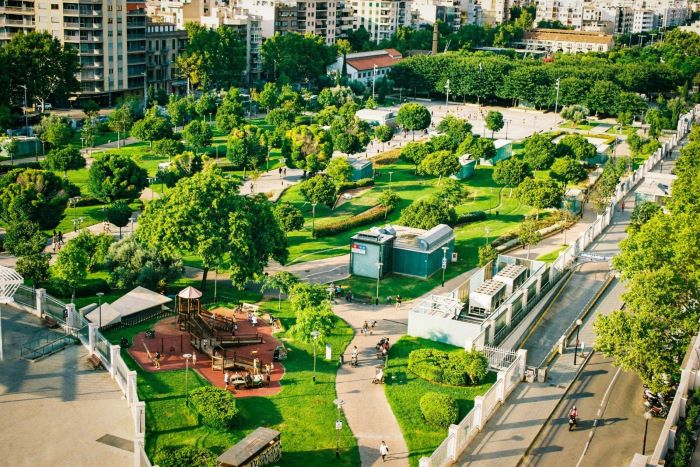Creating a greener neighborhood not only benefits the environment but also improves the quality of life for residents. By implementing sustainable practices and fostering a sense of community, we can work together to create a healthier and more environmentally conscious neighborhood.
In this blog post, we will explore effective ways to create a greener neighborhood. From planting trees and starting a community garden to promoting sustainable transportation and organizing cleanup days, these ideas will inspire you to take action and make a positive impact on your local environment.
Plant trees
Did you know that planting trees in your neighborhood not only enhances its beauty but also provides a multitude of benefits? From providing shade to improving air quality to reducing energy consumption, trees have a significant positive impact on the environment. However, it is important to keep in mind that appropriate measures should be taken to ensure the health and safety of both the trees and the residents in the neighborhood.
One potential concern is rodent extermination in the trees. It is crucial to follow proper procedures to prevent rodents from nesting in the trees, as they can cause damage and carry diseases. By implementing tree planting initiatives through local government programs or community-driven efforts, residents can work together to create a greener, healthier, and more sustainable environment for all.
Start a community garden
A community garden is a fantastic way to bring neighbors together and promote sustainable living. Identify a suitable space in the neighborhood and work with residents to establish a shared garden. Community gardens allow people to grow their own food, fostering a sense of self-sufficiency and reducing the carbon footprint associated with long-distance food transportation.
Encourage organic gardening practices and host workshops to share gardening knowledge among participants. The community garden will not only provide fresh produce but also become a hub for social interaction and neighborhood bonding.
Implement recycling programs
An effective way to create a greener neighborhood is by implementing comprehensive recycling programs. Advocate for the establishment of recycling centers or collection points in your community. Educate residents about proper recycling practices and provide clear guidelines for sorting recyclable materials.
Collaborate with local authorities to ensure regular collection and processing of recyclables. Encourage participation through awareness campaigns and incentives. By making recycling convenient and accessible, you can significantly reduce waste sent to landfills and promote a circular economy within your neighborhood.
Promote sustainable transportation
Reducing reliance on private vehicles and promoting sustainable transportation options are crucial for creating a greener neighborhood. Encourage walking, biking, and the use of public transportation by improving infrastructure such as sidewalks, bike lanes, and public transit accessibility.
Advocate for carpooling and ridesharing initiatives among residents. Organize neighborhood events like “Bike to Work/School” days or walking groups to promote active commuting. By prioritizing sustainable transportation methods, you can reduce carbon emissions, alleviate traffic congestion, and improve air quality in your neighborhood.
Support local farmers’ markets
Supporting local farmers’ markets is a sustainable way to access fresh, locally-grown produce while reducing the environmental impact of long-distance food transportation. Encourage residents to shop at farmers’ markets by promoting their benefits and highlighting the connection to local growers.
Collaborate with local farmers to organize pop-up markets within the neighborhood or nearby community spaces. By supporting local agriculture, you not only contribute to the local economy but also foster a stronger sense of community and promote sustainable farming practices.
Organize neighborhood cleanup days
Taking collective action to keep your neighborhood clean and free of litter is essential for creating a greener environment. Organize regular neighborhood cleanup days where residents come together to pick up trash, remove debris, and maintain public spaces. Provide gloves, bags, and other necessary equipment to participants.
These cleanup events foster a sense of pride and ownership in the community while enhancing the visual appeal of the neighborhood. Additionally, they raise awareness about the importance of waste management and encourage responsible behavior among residents.
Install rain barrels
Conserving water is a vital aspect of creating a greener neighborhood. Install rain barrels in your homes or community spaces to collect rainwater for gardening purposes. Rainwater harvesting reduces reliance on freshwater sources and helps preserve water resources. Educate residents about the benefits of rain barrels and provide guidance on their installation and maintenance.
Consider organizing workshops or demonstrations to showcase the effectiveness of rainwater harvesting. By implementing this sustainable practice, you can minimize water consumption and contribute to a more sustainable water management system in your neighborhood.
Educate and raise awareness
Education and awareness are key to creating a greener neighborhood. Organize workshops, seminars, or community events to educate residents about sustainable practices and the importance of environmental conservation. Collaborate with local environmental organizations or experts to provide valuable insights and practical tips.
Share information through newsletters, social media platforms, or community notice boards. Encourage residents to adopt eco-friendly habits in their daily lives, such as reducing energy consumption, minimizing waste, and practicing responsible consumption. By empowering individuals with knowledge and inspiring action, you can create a greener and more environmentally conscious neighborhood.
Conclusion
Creating a greener neighborhood is within reach when individuals and communities come together to implement sustainable practices. From planting trees and starting a community garden to promoting sustainable transportation and organizing cleanup days, each action contributes to a healthier and more environmentally friendly neighborhood.
By embracing these ideas and fostering a sense of community, you can make a positive impact on the local environment, enhance the quality of life, and inspire others to join the green movement. Together, we can create neighborhoods that prioritize sustainability and contribute to a greener future.


